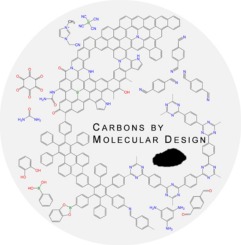当前位置:
X-MOL 学术
›
Mater. Today
›
论文详情
Our official English website, www.x-mol.net, welcomes your feedback! (Note: you will need to create a separate account there.)
Toward a molecular design of porous carbon materials
Materials Today ( IF 24.2 ) Pub Date : 2017-12-01 , DOI: 10.1016/j.mattod.2017.06.002 Lars Borchardt , Qi-Long Zhu , Mirian E. Casco , Reinhard Berger , Xiaodong Zhuang , Stefan Kaskel , Xinliang Feng , Qiang Xu
Materials Today ( IF 24.2 ) Pub Date : 2017-12-01 , DOI: 10.1016/j.mattod.2017.06.002 Lars Borchardt , Qi-Long Zhu , Mirian E. Casco , Reinhard Berger , Xiaodong Zhuang , Stefan Kaskel , Xinliang Feng , Qiang Xu

|
The molecular design of porous solids from predefined building blocks, in particular metal-organic and covalent frameworks, has been a tremendous success in the past two decades approaching record porosities and more importantly was an enabler for integrating predefined molecular functionality (enantioselectivity, optical and catalytic properties) into pore walls. Recent efforts indicate that this concept could also be applicable to rationally design porous and nanostructured carbonaceous materials, a class of materials hitherto and especially in the past often considered as “black magic” in terms of pore-wall structure definition and surface functionality. Carbon precursors with structural and compositional information in their molecular backbone, pre-formed covalent bonds, or integrated functional groups enable the design of carbon materials that can be tailored for certain applications. We review this exciting field of synthetic approaches based on molecular building blocks such as ionic liquids, bio molecules, or organic precursor monomers enabling the design of advanced carbonaceous architectures such as porous carbons, porous carbon-rich polymers or graphene nanoribbons. Moreover, our review includes approaches using the reactive and thermal transformation of periodic crystalline structures such as metal-organic frameworks, or carbides into equally defined carbon material. Such molecularly designed carbons are not only ideal model materials for fundamental science but also emerge in applications with until now unattained functionality.
中文翻译:

多孔碳材料的分子设计
在过去的二十年里,从预定义的构件(特别是金属有机和共价骨架)设计多孔固体的分子设计取得了巨大的成功,接近创纪录的孔隙率,更重要的是,它有助于整合预定义的分子功能(对映选择性、光学和催化性质)进入孔壁。最近的努力表明,这一概念也适用于合理设计多孔和纳米结构的碳质材料,迄今为止,尤其是过去,在孔壁结构定义和表面功能方面,这一类材料通常被认为是“黑魔法”。在其分子骨架中具有结构和组成信息的碳前体、预先形成的共价键、或集成的官能团使碳材料的设计能够针对某些应用进行定制。我们回顾了基于分子构建块(例如离子液体、生物分子或有机前体单体)的合成方法这一令人兴奋的领域,这些分子构建块能够设计先进的碳质结构,例如多孔碳、多孔富碳聚合物或石墨烯纳米带。此外,我们的评论包括使用周期性晶体结构(例如金属有机骨架或碳化物)的反应和热转变为同样定义的碳材料的方法。这种分子设计的碳不仅是基础科学的理想模型材料,而且还出现在具有迄今为止尚未实现的功能的应用中。我们回顾了基于分子构建块(例如离子液体、生物分子或有机前体单体)的合成方法这一令人兴奋的领域,这些分子构建块能够设计先进的碳质结构,例如多孔碳、多孔富碳聚合物或石墨烯纳米带。此外,我们的评论包括使用周期性晶体结构(例如金属有机骨架或碳化物)的反应和热转变为同样定义的碳材料的方法。这种分子设计的碳不仅是基础科学的理想模型材料,而且还出现在具有迄今为止尚未实现的功能的应用中。我们回顾了基于分子构建块(例如离子液体、生物分子或有机前体单体)的合成方法这一令人兴奋的领域,这些分子构建块能够设计先进的碳质结构,例如多孔碳、多孔富碳聚合物或石墨烯纳米带。此外,我们的评论包括使用周期性晶体结构(例如金属有机骨架或碳化物)的反应和热转变为同样定义的碳材料的方法。这种分子设计的碳不仅是基础科学的理想模型材料,而且还出现在具有迄今为止尚未实现的功能的应用中。或有机前体单体,能够设计先进的碳质结构,如多孔碳、多孔富碳聚合物或石墨烯纳米带。此外,我们的评论包括使用周期性晶体结构(例如金属有机骨架或碳化物)的反应和热转变为同样定义的碳材料的方法。这种分子设计的碳不仅是基础科学的理想模型材料,而且还出现在具有迄今为止尚未实现的功能的应用中。或有机前体单体,能够设计先进的碳质结构,如多孔碳、多孔富碳聚合物或石墨烯纳米带。此外,我们的评论包括使用周期性晶体结构(例如金属有机骨架或碳化物)的反应和热转变为同样定义的碳材料的方法。这种分子设计的碳不仅是基础科学的理想模型材料,而且还出现在具有迄今为止尚未实现的功能的应用中。
更新日期:2017-12-01
中文翻译:

多孔碳材料的分子设计
在过去的二十年里,从预定义的构件(特别是金属有机和共价骨架)设计多孔固体的分子设计取得了巨大的成功,接近创纪录的孔隙率,更重要的是,它有助于整合预定义的分子功能(对映选择性、光学和催化性质)进入孔壁。最近的努力表明,这一概念也适用于合理设计多孔和纳米结构的碳质材料,迄今为止,尤其是过去,在孔壁结构定义和表面功能方面,这一类材料通常被认为是“黑魔法”。在其分子骨架中具有结构和组成信息的碳前体、预先形成的共价键、或集成的官能团使碳材料的设计能够针对某些应用进行定制。我们回顾了基于分子构建块(例如离子液体、生物分子或有机前体单体)的合成方法这一令人兴奋的领域,这些分子构建块能够设计先进的碳质结构,例如多孔碳、多孔富碳聚合物或石墨烯纳米带。此外,我们的评论包括使用周期性晶体结构(例如金属有机骨架或碳化物)的反应和热转变为同样定义的碳材料的方法。这种分子设计的碳不仅是基础科学的理想模型材料,而且还出现在具有迄今为止尚未实现的功能的应用中。我们回顾了基于分子构建块(例如离子液体、生物分子或有机前体单体)的合成方法这一令人兴奋的领域,这些分子构建块能够设计先进的碳质结构,例如多孔碳、多孔富碳聚合物或石墨烯纳米带。此外,我们的评论包括使用周期性晶体结构(例如金属有机骨架或碳化物)的反应和热转变为同样定义的碳材料的方法。这种分子设计的碳不仅是基础科学的理想模型材料,而且还出现在具有迄今为止尚未实现的功能的应用中。我们回顾了基于分子构建块(例如离子液体、生物分子或有机前体单体)的合成方法这一令人兴奋的领域,这些分子构建块能够设计先进的碳质结构,例如多孔碳、多孔富碳聚合物或石墨烯纳米带。此外,我们的评论包括使用周期性晶体结构(例如金属有机骨架或碳化物)的反应和热转变为同样定义的碳材料的方法。这种分子设计的碳不仅是基础科学的理想模型材料,而且还出现在具有迄今为止尚未实现的功能的应用中。或有机前体单体,能够设计先进的碳质结构,如多孔碳、多孔富碳聚合物或石墨烯纳米带。此外,我们的评论包括使用周期性晶体结构(例如金属有机骨架或碳化物)的反应和热转变为同样定义的碳材料的方法。这种分子设计的碳不仅是基础科学的理想模型材料,而且还出现在具有迄今为止尚未实现的功能的应用中。或有机前体单体,能够设计先进的碳质结构,如多孔碳、多孔富碳聚合物或石墨烯纳米带。此外,我们的评论包括使用周期性晶体结构(例如金属有机骨架或碳化物)的反应和热转变为同样定义的碳材料的方法。这种分子设计的碳不仅是基础科学的理想模型材料,而且还出现在具有迄今为止尚未实现的功能的应用中。



























 京公网安备 11010802027423号
京公网安备 11010802027423号